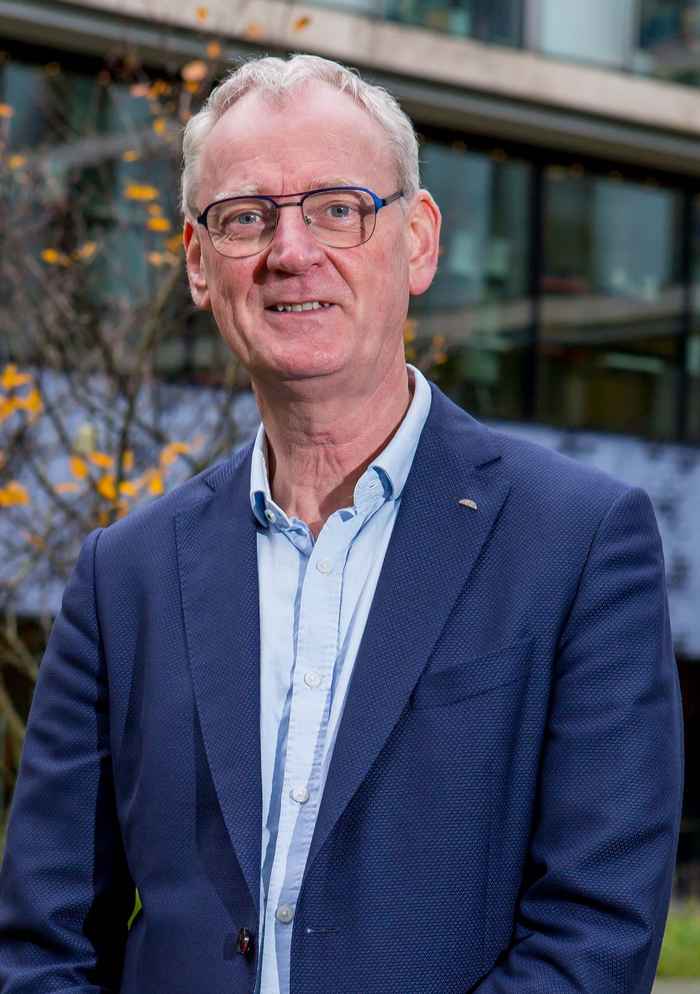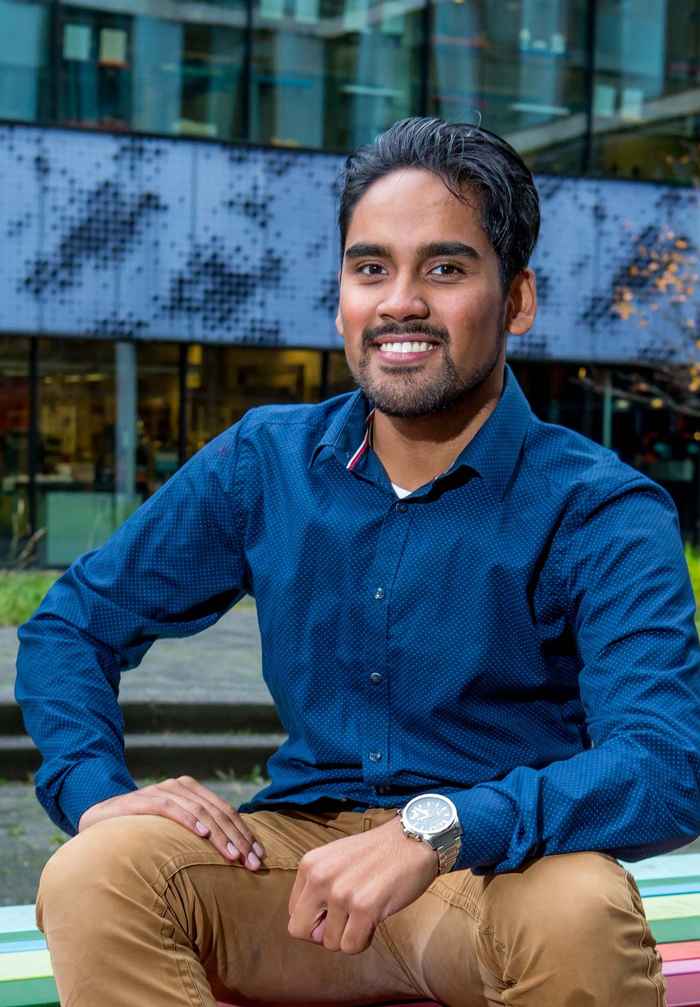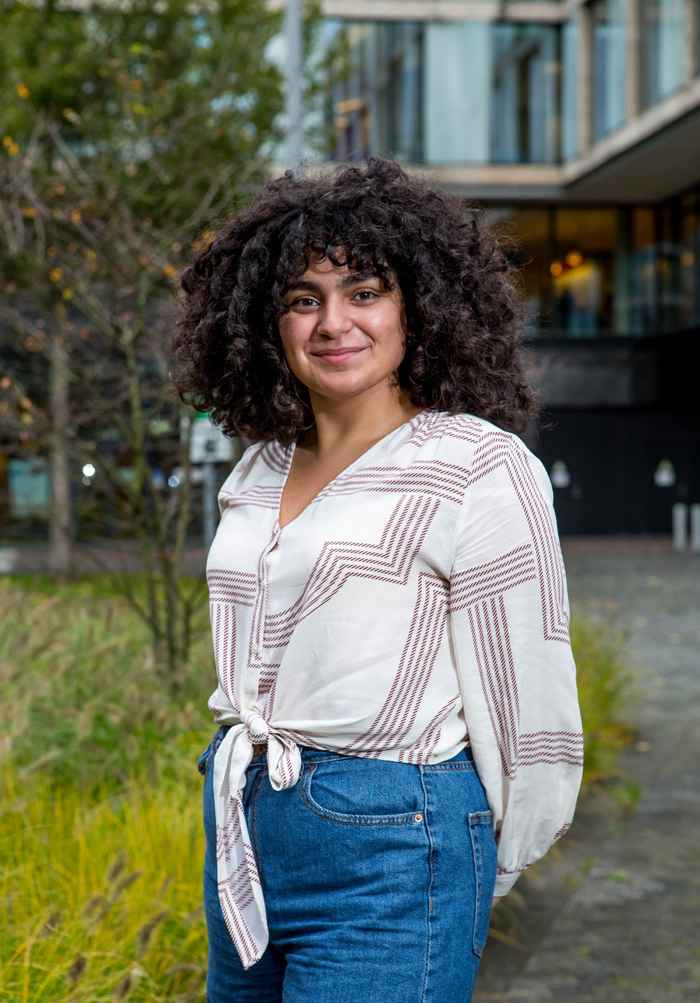20 years Faculty of Science: the past, present and future
21 December 2020

Text: Edda Heinsman.
Taking photos inside isn’t forbidden, but as Van Tienderen explains, the rule is that you have to wear a face mask when you’re not in your workspace. We walk past the distinctive stairs in the centre of the building that connect the labs with the workspaces. Photographer Liesbeth Dingemans seizes her chance. Everyone smile! Only, well, those face masks ...
Van Tienderen, Demirel and Jhinkoe-Rai are pleased to be back at university. Van Tienderen says most of his meetings are now online. 'It works, but it’s not as nice; you miss the casual contacts. You're not going to book a Zoom meeting just for a quick question. The advantage is that most people in my online meetings already know each other, which makes it easier to crack a joke and discuss things in a relaxed way. I think it must be very hard for new first-year students.'
Demirel picks up on that comment. 'I started this academic year with a major in Pedagogy. I didn’t know anyone. It’s really nice to be able to meet with a group for at least an hour every two weeks.' She also has one hour of contact time every fortnight: a seminar. Jhinkoe-Rai is less lucky; he doesn’t have any in-person meetings at the moment. 'All of the student council meetings are online too. It’s weird, different from normal, but you get used to it', he says.
Drugs
They’re slowly getting used to dealing with the Coronavirus pandemic and the associated protocols. Some practical problems are yet to be tackled. 'One of the challenges is to find a suitable work placement position for all students', says Van Tienderen. 'Luckily, the faculty has good connections with the business community.' Jhinkoe-Rai agrees. “I've been to several companies for my The Analytical Chemist in Industry course. My final placement will be with the Amsterdam Police for my Master’s thesis. I’m going to research substances that are not yet illegal, but are actually similar to certain types of drugs. Chemistry is everywhere.' When he starts talking about this research, Jhinkoe-Rai’s eyes light up. 'I took a course with Arian van Asten, what a lecturer! He talks about his subject with such passion, every lecture is like watching an episode of NCIS. I’m really lucky to be able to do my research with the police.'
Dinosaurs
We keep walking through the building. Van Tienderen points out the recently constructed new study spaces, built above a number of large research areas. 'It will be a while before the new building is completed, but in the meantime, every square metre is being put to good use.' There are a few students working. We don’t want to bother them for long, so we walk towards the Science Lounge. It’s a meeting room with a large table, which features a landscape with dinosaurs instead of a classic floral arrangement. 'It’s funny, isn’t it?' says Demirel. I’d love to sneak in a few more.' 'I don’t like it', Van Tienderen laughs. 'I’d be happy if you took it with you!'
During a short round of introductions, Demirel mentions she’s a student assessor. What does that mean? 'The directors and the dean have a lot of contact with the student council, which represents students’ interests. But there’s still a gap between the student council and the board above it. As a student assessor, I’m trying to bridge the gap and reduce that distance. I attend board meetings and provide the student perspective.' Jhinkoe-Rai adds: 'There’s a set protocol in the student council: if something happens, a file is created and the issue is discussed with the board.' Demirel says, 'For me, it’s more like if there’s something going on that doesn’t have a file yet, I can easily discuss it with the dean.'
'That’s very useful for me', says Van Tienderen. 'We catch up every week and talk about what’s happening. I can also have something read and ask how it comes across. Things that might make sense from my perspective don’t necessarily make sense to students.' He quickly adds: 'Not that Hilal represents the whole world and all students, but it’s nice to hear a student’s perspective.'

Gender-inclusive streetwear
Van Tienderen considers student participation to be very important, in terms of policy and education, as well as more informal matters. 'Last year, the student council suggested we come up with something to promote diversity and inclusiveness. So we created the Grassroots Science4all Fund, for which students and staff in the Faculty of Science can submit proposals.' The money is used to organise activities that promote diversity. Some of the proposals that have received money so far include a knowledge evening for local children and their families, homework assistance for students from a lower socioeconomic background and a fashion show of gender-inclusive streetwear, made from an innovative new material. 'The idea for Grassroots Science4all came from students and has become very successful', says Van Tienderen. 'It’s a good initiative. Together, we can achieve things I wouldn’t think of by myself.'
Twenty years of the Faculty of Science
How has the Faculty of Science changed over the past twenty years? The students look at each other and laugh; Jhinkoe-Rai was in nappies twenty years ago, and Demirel hadn't even been born yet. But Van Tienderen can tell us a thing or two; he started at the UvA in 2001. 'Back then, only Biology was at the Science Park. Everything was smaller; we had a small building, we all went to the canteen together, there was fish on Fridays, that sort of thing.' Van Tienderen thought things were good back then, but he’s not really nostalgic. 'Now that other programmes have come to the Science Park, there’s a lot more interaction between them. It’s really made a world of difference.' Both students say they’re happy with the campus at the Science Park. 'It’s a nice place, it still feels quite small, at least compared to Utrecht', says Jhinkoe-Rai, who did his Bachelor’s at Utrecht.
Van Tienderen thinks the enormous growth of the faculty, from 2500 to 7000 students, might be the biggest change. Every degree programme has grown, and some new courses have been added. To accommodate all those students, new lecture rooms have been built and the library has been downsized. Isn’t that a shame? Demirel says, 'I’ve never felt the need to go to the library to look anything up.' Jhinkoe-Rai agrees. 'I could do my studies without physical books.'
Van Tienderen can't help but laugh. 'Things were very different twenty years ago. Even more so when I started, forty years ago!' He had to go to the library to read articles. He had to look things up on microfiche: small, semi-transparent sheets of plastic, printed with tiny writing. You magnified the writing with a kind of overhead projector. Once you knew where the article was, you could request it. 'You would send an stamped envelope to an author, and you would get the article sent back by post, usually weeks later!' The students can’t imagine what that was like. Demirel points out that this would require a totally different way of studying. 'You’d have to plan a lot more. I can go online the night before a lecture, and with the click of a button I have access to every scientific publication.'

Collaboration
Van Tienderen says a lot has also changed in the area of research. 'You used to be personally involved in all aspects of the research, from setting up the experiment to taking the measurements, doing the analysis and writing articles. These days research is less of an individual endeavour; more collaboration is needed to produce the end product.' According to Van Tienderen, this requires new methods of teaching. 'Students have to learn different things, following the T model: not just in-depth knowledge, but the ability to cooperate with a broad range of people. Some degree programmes are now very specialised. It’s good to remember that team performance is becoming increasingly important.'
Talking about the faculty’s past soon turns into a discussion about the future. Van Tienderen notes that today’s students want to contribute to finding solutions to big questions, for example in the field of climate and sustainability. 'One of the things we’re working on is the new Science and Design programme. It’s about translating our science into new organisms or new materials', he says. 'You think of something, then design it. Transforming plants to make them more resistant, or developing new materials with highly predictable properties. Not just searching for the fundamentals, but also taking a new approach to searching, in terms of both depth and breadth.' Demirel and Jhinkoe-Rai find this development interesting, because they can see it happening around them: their fellow students want to add something, they want to solve concrete problems. Scientific research, applied in practice. Van Tienderen looks proud. 'The students are the ones who ultimately have to do it.'
Other interviews
- 20 years Faculty of Science: the past, present and future of Biology
- 20 years Faculty of Science: the past, present and future of Biomedical Sciences
- 20 years Faculty of Science: the past, present and future of Psychobiology
- 20 years Faculty of Science: the past, present and future of Informatics
- 20 years Faculty of Science: the past, present and future of Information Studies
- 20 years Faculty of Science: the past, present and future of Artificial Intelligence
- 20 years Faculty of Science: the past, present and future of Chemistry
- 20 years Faculty of Science: the past, present and future of Physics and Astronomy
- 20 years Faculty of Science: the past, present and future of Mathematics
Follow UvA_Science on Instagram and Twitter and stay informed of scientific insights and the latest news about the Faculty of Science.
